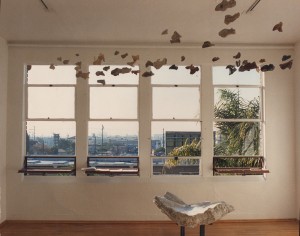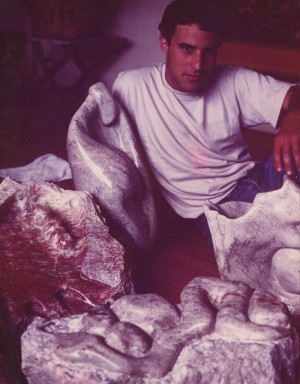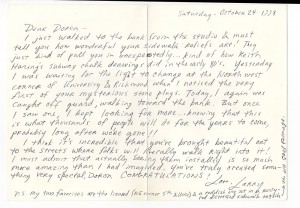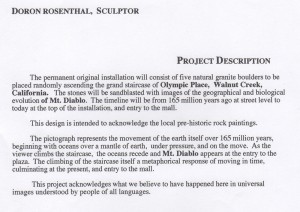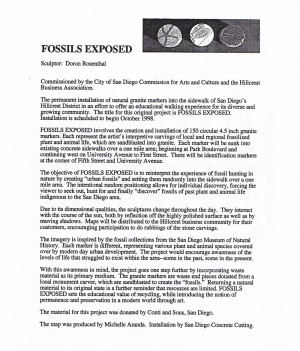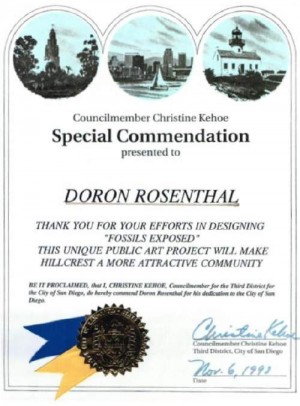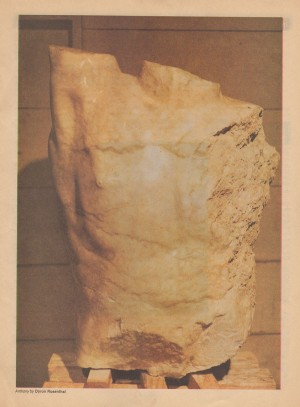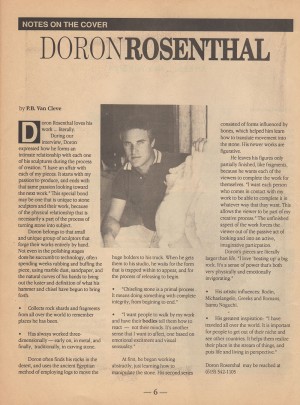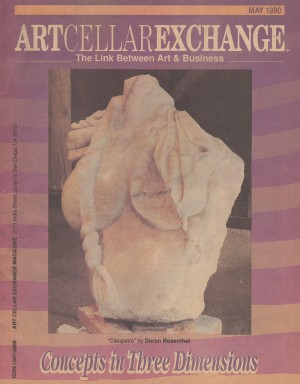“Geological and Biological Evolution of Mt. Diablo, as told in five stones”
Doron Rosenthal, Sculptor
Project Description
The permanent original installation will consist of five natural granite boulders to be placed randomly ascending the grand staircase of Olympic Place, Walnut Creek, California. The stones will be sandblasted with images of the geographical and biological evolution of Mt. Diablo. The timeline will be from 165 million years ago at street level to today at the top of the installation, and entry to the mall.
This design is intended to acknowledge the local pre-historic rock paintings.
The pictograph represents the movement of the earth itself over 165 million years, beginning with oceans over a mantle of earth, under pressure, and on the move. As the viewer climbs the staircase, the oceans recede and Mt. Diablo appears at the entry to the plaza. The climbing of the staircase itself a metaphorical response of moving in time, culminating at the present, and entry.
This project acknowledges what we believe to have happened here in universal images understood by people of all languages.
FOSSILS EXPOSED
Sculptor: Doron Rosenthal
Commissioned by the City of San Diego Commission for Arts and Culture and the Hillcrest Business Association.
The permanent installation of natural granite markers into the sidewalk of San Diego’s Hillcrest District in an effort to offer an educational walking experience for its diverse and growing community. The title for this original project is FOSSILS EXPOSED. Installation is scheduled to begin October 1998.
FOSSILS EXPOSED involves the creation and installation of 150 circular 4.5 inch granite markers. Each represent the artist’s interpretive carvings of local and regional fossilized plant and animal life, which are sandblasted into granite. Each marker will be sunk into existing concrete sidewalks over a one mile area; beginning at Park Boulevard and continuing west on University Avenue to First Street. There will be identification markers at the corner of Fifth Street and University Avenue.
The objective of FOSSILS EXPOSED is to reinterpret the experience of fossil hunting in nature by creating “urban fossils” and setting them randomly into the sidewalk over a one mile area. The intentional random positioning allows for individual discovery, forcing the viewer to seek out, hunt for and finally “discover” fossils of past plant and animal life indigenous to the San Diego area.
Due to its dimensional qualities, the sculptures change throughout the day. They interact with the course of the sun, both by reflection off the highly polished surface as well as by moving shadows. Maps will be distributed to the Hillcrest business community for their customers, encouraging participation to do rubbings of the stone carvings.
The imagery is inspired by the fossil collections from the San Diego Museum of Natural History. Each marker is different, representing various plant and animal species covered over by modern day urban development. The project would encourage awareness of the levels of life that struggled to exist within the area–some in the past, some in the present.
With this awareness in mind, the project goes one step further by incorporating waste material as its primary medium. The granite markers are waste end pieces donated from a local monument carver, which are sandblasted to create “fossils.” Returning a natural material to its original state is a further reminder that resources are limited. FOSSILS EXPOSED sets the educational value of recycling, while introducing the notion of permanence and preservation in a modern world through art.
The material for this project was donated by Conti and Sons, San Diego
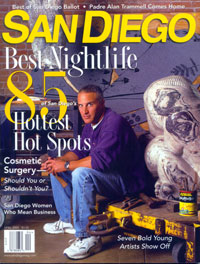
MOST EXCITING ENTRY AWARD
DORON ROSENTHAL
April 2000
On the Cover: The hottest new artists are hitting the Gaslamp this month. Doron Rosenthal won “Most Exciting Entry” in the Sony ArtWalk 2000 competition.
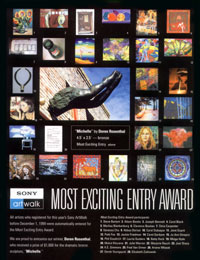
Page 53:
Rosenthal, whose sculpture was awarded “most Exciting Entry” for SonyArtWalk 2000, finds joy in the very act of creation. While the end product of his artistic efforts is simply a reflection of the creative process, Rosenthal’s passion is derived solely from the zen quality of the work itself.
ARTWEEK
THE SENSUALITY OF STONE
by Michael McManus, February 1987
Stone carving is more than a technique. Direct and manual it is inseparably intertwined with the prehistoricproduction of hand-axes and spearheads–those primal extensions of tooth and claw that divide the human realm from the other seamless entirety of nature. Stone carving obsesses an immense metaphysical dimension. It is an emblem of agonistic character of art-making, of the struggle to remold a hard, resistant material (and my analogy, the world) into a personal expression of good and true adn beautiful. Stone carving is also an anachronism, an activity that was beginning to look faintly quixotic even in Michelangelo’s time, when the visitation of the stucco angel signaled the dawn of the age of mechanical reproduction. But like Don Quixote, many people today find no satisfying substitutes for goodness, truth and beauty in simulations, digital logic and coded reassurances of neo-Berkelian hyperrealists that everything is relative (to the system) and that the real and the simulated are categorically interchangeable (if being understood that the simulation is somehow more “interesting” this season).
Those dinosaurs in the viewing audience who still prefer “the real thing” to its simulacrum, who scrutinize the work’s edges to the banked flares and faint illuminations of its aura (however whithered), may find the traditional object of their ritual pleasures in the stone carvings of Doron Rosenthal on view at the Natalie Bush Gallery through January.
Rosenthal is young. This is his first one-person gallery showing and it is a formidable debut–shot through with intrigue, novelty and sensual enjoyments that evoke in many a profound meditation on the preconditions and ends of modern sculpture. Alabaster is the artist’s metier, locally indigenous alabaster for which he sours the Anza-Borrego and the wild lands around the San Bernardion mountains. He carves these interestingly colored slabs of hard, compact calcite to play the slight translucency of the stone against its beautiful banding and layers. In two formally related works, Medusaand and Maelstrom (both 1986), Rosenthal takes the sort of plate-tableau motif that Giacometti developed in The Palace at 4 A.M. (1932-33) returns it to the geological realm of the tectonic plate. Medusa turns the stone plate at a right angle to set the arrangement of the surfaces before the viewer, like a low relief. Unlike classic low-relief, however, the work’s vertical faces, giving the eye a sense of panoptic omnipresence–an illusion of examining something very large and being immeasurably larger oneself.
Maelstrom plays a similar game with a horizontal flow of stone facing that bears an irregular raised X surrounding a funnel hole. There is in these works and old-fashioned modernist sort of subtlety elaborately polished detail that is set against a simplicity of overall shape (the shard fragment) thus generating an excruciating contrast. The alabaster of Medusa is dark, cold gray faced with veins and pools of rosy white. The stone of Maelstrom is an even middle gray with homogeneous salt-and-pepper flecks set in fine layers like magnetized iron filings. Individual features and articulated areas of Rosenthal’s works evoke ground-down mortars, glacial grooves carved in northern bedrock, dolmens and menhirs and the Venuses of Lespungue and of Willendorf.
In Stone Shell (1985) the artist has fashioned a massive, irregular, organic, spiral shape. Ponderous and improbable, the piece balances on its small, flat base. The open mouth of the spiral reveals a rounded U-shape similar to the yoni form that signifies the feminine principle in Tantric Buddhist art. A western European equivalent, “the delta of Venus,” characterizesI saw bone like that once (1986). In this piece, the form is roughly an isosceles triangle, point down. The work is posted at eye level on a tall, slender steel cylinder. An inverted teardrop-shaped hole is cut through the center of the stone triangle. Even ridges, like the knuckles of a clenched fist, radiate downward from the upper side edge of the hollow. The work is at once closed and open. The pale multicolored banding of the stone is fascinating, and much of the shape and orientation of the carving aims to reveal this banding to best advantage.
As battle lines are being drawn in late twentieth-century art between technological critial-media artists and authenticists/auta object artists. Rosenthal has clearly positioned himself in the latter camp. This show of stoneworks is a strong opening gambit.
